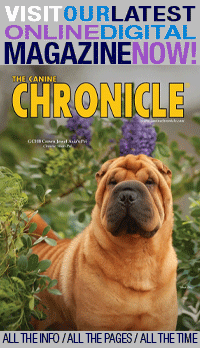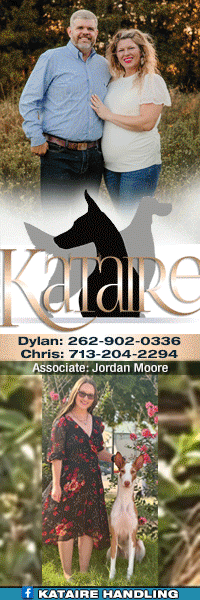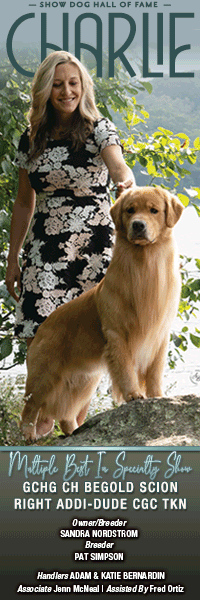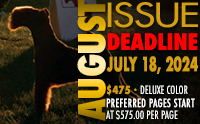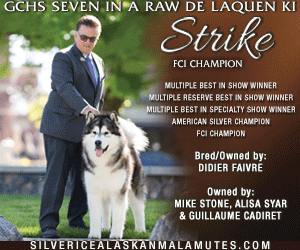Self-Portrait With Dog – A Tradition Among Painters
Click here to read the complete article
text and illustrations by Ria Hörter
While researching this article, I didn’t find any reference to self-portraits with dogs from classical antiquity. Only during the Renaissance, with its renewed interest in secular art and the individual as a subject, did self-portraits become popular.
This article will be limited to paintings with dogs that can be identified as a breed or type.
Self-portraits with dogs were probably first seen in the Netherlands, but the custom spread over the whole of Europe as a means of advertising an artist’s work, especially in portraiture.
Generally speaking, when a dog was included in a self-portrait, it was owned by the painter or the painter’s family. What could be the reason for painting a self-portrait with a dog owned by somebody else? In some cases, the dog’s ownership was emphasized by, for example, a hand on the dog’s head or an arm around its body: This dog is my dog.
From Leonardo da Vinci in the 15th century to Antonio Ligabue in the 20th – here is a look at six ages of artists and their dogs.
Leonardo da Vinci (Italian),
Self-portrait with Dog – ca. 1475
The earliest self-portrait with dog I have found was painted by Leonardo da Vinci (1452-1519). A Florentine architect, philosopher, inventor, painter, mathematician, engineer, scientist, writer, composer and sculptor, da Vinci is considered a homo universalis.
Da Vinci worked for wealthy Milanese and Florentine families such as the Sforzas and Borgias. His best-known work, the Mona Lisa, hangs in the Louvre in Paris.
One of da Vinci’s self-portraits shows the artist with a small white dog. Several authors have stated that the dog could be the forerunner of the Volpino Italiano. In the 15th century, small Spitz-type dogs with a white or red coat were popular with the Italian nobility and artists. Another name for Volpino Italiano is Volpino Quirinale; “Quirinale” refers to one of Rome’s seven hills.
Da Vinci’s somewhat dark self-portrait was made between 1475 and 1480 when the artist was about 23 years old.
Rembrandt van Rijn (Dutch),
Self-portrait in Oriental Attire – 1631
Rembrandt van Rijn (1606-69) was a master at painting self-portraits; he made almost a hundred of them.
In 1631, 24 years old, Rembrandt painted a portrait of himself dressed in an oriental costume. Although he often dressed in unusual clothing, the combination of oriental and dog was exceptional. Quite exceptional, because the dog was added two years later, in 1633.
The dog is a “water dogge,” possibly a poodle; you can see that its hindquarters have been shaved. “As hunting was the prerogative of royalty and the nobility, the poodle became a sort of status symbol. Thus, several French sovereigns owned poodles and Prince Rupert, the son of Frederick V, the Elector Palatine known as the ‘Winter King’ who sought refuge in The Hague, had a poodle that answered to the name of Boy. So it is possible that Rembrandt chose the breed to enhance the princely stature of his disguse.” (from Edwin Buijsen, exhibition catalogue Rembrandt by himself, National Gallery, London, with the Mauritshuis, The Hague, 1999)
On the other hand, the dog could be a forerunner of the Spanish or Portuguese Water Dog. During the Dutch Revolt from 1568-1648, Spanish soldiers occupied the Netherlands for decades and it is very well possible that they had their dogs with them.
At that time, Rembrandt was not yet skilled at painting dogs; the forelegs compared to the body are coarse, and the feet have enormous toes.
There is no communication at all between dog and master – not surprising, since the dog was added to an existing portrait.
Alexandre-François Desportes (French),
Self-portrait in Hunting Dress – 1699
This self-portrait of French painter Alexandre-François Desportes (1661-1743) is now very popular in Europe as an illustration in articles and books about hunting. Desportes was a specialist when it came to working dogs.
Self-portrait in Hunting Dress demonstrates his virtuosity with a paint brush. He was a master of detail; look, for example, at the expression on the faces of both dogs, and the texture of the beautiful blue coat. Desportes’ knowledge of canine anatomy can be seen in many of his other paintings. When he went hunting, the painter always took along a small sketchbook. His clients chose from the sketches and Desportes worked the chosen sketch into a painting.
This painter was a bit of a dandy, but he did well by it. The French kings Louis XIV and Louis V were some of his royal clients.
The dog on the left is a sighthound of Greyhound type. In art-historical descriptions, the dog on the right is identified as a Pointer, but it’s likely one of the many French braques. It has a white coat with black ticking and patches. It could be a forerunner of the French Grand Gascon Saintongeos or Braque d’Auvergne, or the Ariegeois.
William Hogarth (English),
The Painter
and his Pug – 1745
In English painter William Hogarth’s (1697-1764) self-portrait, the dog is at least as prominent as its master.
After apprenticing with a goldsmith, Hogarth began producing engravings and paintings – satirical and moral works as well as portraits and Biblical scenes. At 48, he painted a self-portrait with one of his two Pugs – Pug and Trump. Trump always stayed close to its master and is the dog immortalized here.
Pugs became popular in England when King William III, viceroy of the Netherlands, and his English wife, Queen Mary II, took their Pugs with them from Holland to England. Everybody knew that the Pug was the favorite breed of the House of Orange.
Apart from his dog, Hogarth included several attributes in the painting: his palette, with the text “The line of beauty and grace” referring to his theories about art and the serpentine line; and a stack of books by William Shakespeare, John Milton and Jonathan Swift, a reference to Hogarth’s favorite writers, or to emphasize that he was a man of wide reading.
Gustave Courbet (French),
Courbet with a Black Dog – ca. 1842
In Hogarth’s self-portrait with his Pug, the artist is modest and stony-faced; Gustave Courbet’s self-portrait with a black dog is quite the opposite.
Courbet (1819-77), a French painter, was a marked socialist who addressed social issues in his work and painted the reality of everyday life without romanticizing his subjects. Courbet courted controversy and his later nudes in particular caused a scandal. He is counted as a leader of Realism and a forerunner of Impressionism.
His self-portrait with a black dog was painted in the Romantic style between 1842 and1844, at the beginning of Courbet’s career. In 1844 it was accepted for exhibition at the influential Salon de Paris.
A description of this painting reads: “His elegant clothes with the coat carefully turned back to reveal the dashing yellow lining, his fashionable English Spaniel, and the lofty perch from which he can cast a rather superior gaze down upon the world beneath him, identify him quite clearly as a dandy. The image of the dandy is fused with that of the country boy that Courbet in fact was, the fellow who goes on long tramps in the woods and fields with his faithful dog and his briar stick, taking a rest now and then to enjoy his pipe.” (gustave-courbet.com)
He has taken his walk with a book, and knowing that the subject is a painter, we might assume this is a sketchbook. Master and dog are looking at us and it seems that one is no more important than the other. The details of the black dog can hardly be seen, but it’s not “a fashionable English Spaniel” as we know English spaniels today; it would have been better described as a fashionable spaniel from England.
Dogs occur in many of Courbet’s paintings. Art historians state that black dogs in myths and popular belief have a link with the devil, but I think it’s just his black spaniel. He painted another self-portrait with a black spaniel in 1842. It is the same dog, but only its head is visible.
 Miroslav Kraljevi? (Croatian),
Miroslav Kraljevi? (Croatian),
Autoportret sa Psom – 1910
Croatian painter, engraver and sculptor Miroslav Kraljevi? (1885-1913), who was active at the beginning of the 20th century, is seen as the father of modern Croatian art. His works are Impressionist, Pointillist and Expressionist in style. His Autoportret sa Psom (Self-portrait with Dog) shows the characteristics of Impressionism with its open composition.
After studying in Munich, Kraljevi? returned to his parents’ house in Požega, Croatia, and was staying there in 1910-11. Therefore, we may suppose that Kraljevi? painted Autoportret sa Psom in his parents’ house, and the dog belonged to his parents.
The painter looks out of the corner of his eyes with a stony expression; the dog’s expression is soft, almost melancholy.
There is no doubt about the breed: a German Shepherd Dog, whose type fits exactly the drawings of Kraljevi?’s contemporary, Richard Strebel, a well-known German dog writer.
In 1911, Kraljevi? received a government grant that allowed him to study in Paris. A year later, he returned home because of the first symptoms of tuberculosis, but continued to paint. After two months in a sanitarium, he died in Zagreb in 1913, only 27 years old. Kraljevi?’s Autoportret sa Psom is considered one of his best portraits.
Pyotr Konchalovsky (Russian),
Self-portrait with Dobermann – 1933
Russian painter Pyotr Konchalovsky (1876-1956) was born in what is now Ukraine, and studied in Moscow, Paris and St. Petersburg. Konchalovsky began painting landscapes and still lifes, influenced by French painter Paul Cézanne; his first solo exhibition was in the Tretyakow Gallery in Moscow. Later, he specialized in portraits that were considered examples of “socialistic realist” style. A productive worker, he is known to have created more than 5,000 paintings.
In his 1933 self-portrait, the winter landscape and his fur coat and hat suggest his country, Russia. There’s no doubt about the breed: a Dobermann.
In 1949, Konchalovsky made another painting with a Dobermann, held on leash by his grandson Andron Konchalovsky, dressed in shorts, a checked shirt and red neckerchief. Andron was a member of the Russian Pioneers, a sort of Boy Scouts, set up to mould young people into useful Communists. No doubt the Dobermann was a family dog.
Frida Kahlo (Mexican),
Autorretrato con Changuito – 1945
The work of Mexican painter Frida Kahlo (1907-54) has been described as naive or folk art, but also as Surrealist, a label Kahlo rejected.
When she was 18 years old, Kahlo was seriously injured in a bus accident and bedridden for months. To pass the time, she painted dozens of self-portraits.
In 1929 she married the Mexican painter Diego Rivera. Both had numerous extramarital affairs, including Kahlo’s with Leon Trotsky after he fled Russia and gained asylum in Mexico in 1937.
Frida Kahlo’s house swarmed with animals: monkeys, parrots, dogs and a deer. Her unconventional spirit is obvious in her many self-portraits, including Autorretrato con Changuito (Self-portrait with Monkey) that she painted in 1945, and in which she is tied by a yellow ribbon to her pet monkey, her dog, a pre-Colombian figure, and her signature. The ribbon is thought to symbolize her close bonds with her animals and heritage. The nail is a symbol for pain.
The breed is easily identified as a Xo-loitzcuintli, an ancient Aztec breed. It comes in three sizes – Toy, Miniature, and Standard – and two varieties – Coated and Hairless. The skin is brown to blue-gray or black.
In Aztec history, hairless dogs, named Itzquintle (dog), were the guides for the dead. No doubt, the hairless dogs in many of her paintings were Kahlo’s own. In 1944 she was photographed with two of them.
After 32 surgical operations in 29 years, it was the amputation of her right leg that caused Kahlo finally to give up the battle. An overdose of painkillers and a suicide note in her diary in 1954 were the last acts of her short life.
Rolf Stoll (American),
Pater Familias – 1947
Although considered an American painter, Rolf Stoll (1892-1978) was born in Heidelberg, where he attended a military academy and developed an interest in art. His first training was at the Academy of Fine Arts in Karlsruhe and at the Academy of Fine Arts in Stuttgart, both in southern Germany. In 1912, Stoll emigrated to the United States; after studying at the National Academy of Design in New York, he moved to Cleveland, where he worked as a commercial artist before becoming known as a talented portraitist. As well, he painted figure subjects and floral still lifes, and views of the Ohio countryside, Canada and Spain, all in a Realist style.
Stoll was certainly not a prolific dog painter; apart from the self-portrait with his two Dachshunds, I have not been able to find another example with a dog. The portrait – named Pater Familias – was painted around 1948 in the Realist style. His two Smooth friends look in different directions and it seems that one of them is interested in Stoll’s art. The artist is smiling and holds a pencil to emphasize his artistic calling.
The American Kennel Club describes the Dachshund as a lovable, playful companion… an ideal pet for many homes. Dachshunds can be Standard or Miniature size, and come in three coat varieties – Smooth, Wirehaired or Longhaired.
Antonio Ligabue (Italian),
Autoritratto con Cane – 1957
We started with Leonardo da Vinci in Italy and end our journey back in Italy with Antonio Ligabue (1899-1965; his real name is Laccabue). Ligabue was born in Switzerland; his father (unknown) came from the Italian province of Reggio Emilia.
His childhood was turbulent and characterized by misbehavior and a talent for drawing. He lead a roving life as a farm hand. In 1919, he was expelled from Switzerland. In 1920, he was offered a job on the banks of the River Po and began to paint. He was committed several times to psychiatric hospitals over the course of his life; his temperament was slightly violent. Ligabue’s nickname was Al Matt (mad man).
Ligabue was self-taught. His style is identifiable; the colors orange and green occur frequently. Apart from self-portraits, he painted wild animals, landscapes, horses, birds, poultry, dogs and scenes from farm life.
After 1946, art connoisseurs became interested in Ligabue and his work, which was classified as native art. A catalogue with his paintings was published in 2002, and in 2008, a solo exhibition was organized in the Palazzo Reale in Milan.
Auroritratto con Cane (Self-portrait with Dog) was painted in 1957. Antonio knew about dogs and made beautiful, modern paintings of setters in the field. He painted himself as he looked: expressive eyes, a large curved nose and large ears – it’s almost a caricature.
There is no doubt about the breed of the big dog with pendulous ears and a coat with orange spots. The Bracco Italiano is his dog.
The breed standard requires a white coat, or a white coat with patches of varied size of an orange or more-or-less dark-amber color, or white with more-or-less large chestnut patches, or white speckled with pale orange (melato), or white speckled with chestnut (roano-marrone).
The Bracco’s coat is short, dense and glossy, finer and shorter on the head, ears, front part of the legs and feet. A symmetrical facial mask is preferred, but the absence of a mask is tolerated.
Antonio Lugabue died in 1985 in Gualtieri, Italy.
From the 15th century to the 20th: six ages of self-portraits with dogs. The 15th-century small white dog by Leonardo da Vinci and the 20th-century white-orange gun dog of Antonio Ligabue prove there is nothing new under the sun.
Ria Hörter is a dog writer from The Netherlands. She is the contributing editor of various Dutch dog magazines and works for the Dutch Kennel Club. She was a finalist twice in the annual Dog Writers Association of America writing competition for her articles in Dogs in Canada. On April 12, 2014, she was awarded the Dutch Cynology Gold Emblem of Honour presented by the Dutch Kennel Club. For more information visit: riahorter.com
We have tried to find the names of all photographers, etc. Unfortunately, we did not always succeed. Please send a message to the author (riahorter.com) if you think you are the owner of a copyright.
Short URL: http://caninechronicle.com/?p=92942
Comments are closed
